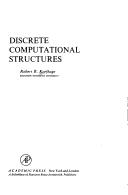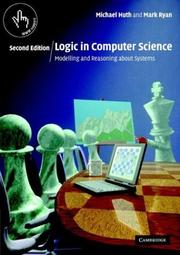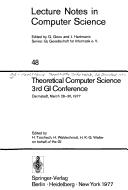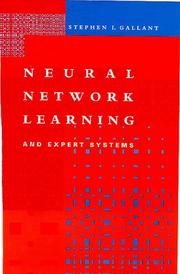| Listing 1 - 10 of 151 | << page >> |
Sort by
|

ISBN: 0124208509 9780124208506 Year: 1974 Publisher: New York, NY : Academic Press,
Abstract | Keywords | Export | Availability | Bookmark
 Loading...
Loading...Choose an application
- Reference Manager
- EndNote
- RefWorks (Direct export to RefWorks)
Discrete mathematics --- Electronic digital computers --- Computer science --- Programmation des ordinateurs --- Informatique --- Programming --- Mathematics --- Mathématiques --- Computer programming --- Data processing --- -Computer programming --- 681.3*F11 --- 681.3*F41 --- Computers --- Electronic computer programming --- Electronic data processing --- Programming (Electronic computers) --- Coding theory --- Math --- Science --- Models of computation: automata; bounded action devices; computability theory; relations among models; self-modifying machines; unbounded-action devices--See also {681.3*F41} --- Mathematical logic: computability theory; computational logic; lambda calculus; logic programming; mechanical theorem proving; model theory; proof theory;recursive function theory--See also {681.3*F11}; {681.3*I22}; {681.3*I23} --- Computer programming. --- Data processing. --- 681.3*F41 Mathematical logic: computability theory; computational logic; lambda calculus; logic programming; mechanical theorem proving; model theory; proof theory;recursive function theory--See also {681.3*F11}; {681.3*I22}; {681.3*I23} --- 681.3*F11 Models of computation: automata; bounded action devices; computability theory; relations among models; self-modifying machines; unbounded-action devices--See also {681.3*F41} --- Mathematics - Data processing --- Mathématiques
Book
ISBN: 3540137211 0387137211 3642699677 3642699650 9780387137216 9783540137214 Year: 1987 Volume: 9 Publisher: Berlin Springer-Verlag
Abstract | Keywords | Export | Availability | Bookmark
 Loading...
Loading...Choose an application
- Reference Manager
- EndNote
- RefWorks (Direct export to RefWorks)
681.3*F11 --- 681.3*F41 --- Models of computation: automata; bounded action devices; computability theory; relations among models; self-modifying machines; unbounded-action devices--See also {681.3*F41} --- Mathematical logic: computability theory; computational logic; lambda calculus; logic programming; mechanical theorem proving; model theory; proof theory;recursive function theory--See also {681.3*F11}; {681.3*I22}; {681.3*I23} --- 681.3*F41 Mathematical logic: computability theory; computational logic; lambda calculus; logic programming; mechanical theorem proving; model theory; proof theory;recursive function theory--See also {681.3*F11}; {681.3*I22}; {681.3*I23} --- 681.3*F11 Models of computation: automata; bounded action devices; computability theory; relations among models; self-modifying machines; unbounded-action devices--See also {681.3*F41} --- Logic, Symbolic and mathematical --- Logique mathématique --- Constructive mathematics --- Mathématiques constructives --- Logic, Symbolic and mathematical. --- Logique mathématique. --- Constructive mathematics. --- Mathématiques constructives. --- Logique mathématique --- Récursivité, Théorie de la --- Computational Complexity --- Recursion --- Analysis --- Computability --- Recursive Function --- Flowchart --- Logique mathematique --- Calculabilite --- Computer science
Book
ISBN: 3540108351 3540387226 Year: 1981 Publisher: Berlin ; Heidelberg ; New York, NY : Springer-Verlag,
Abstract | Keywords | Export | Availability | Bookmark
 Loading...
Loading...Choose an application
- Reference Manager
- EndNote
- RefWorks (Direct export to RefWorks)
Computer science --- 681.3*F11 --- Models of computation: automata; bounded action devices; computability theory; relations among models; self-modifying machines; unbounded-action devices--See also {681.3*F41} --- 681.3*F11 Models of computation: automata; bounded action devices; computability theory; relations among models; self-modifying machines; unbounded-action devices--See also {681.3*F41} --- Distribution (Probability theory. --- Statistics. --- Probability Theory and Stochastic Processes. --- Statistics, general. --- Statistical analysis --- Statistical data --- Statistical methods --- Statistical science --- Mathematics --- Econometrics --- Distribution functions --- Frequency distribution --- Characteristic functions --- Probabilities

ISBN: 052154310X 9780521543101 Year: 2004 Publisher: Cambridge : Cambridge University Press,
Abstract | Keywords | Export | Availability | Bookmark
 Loading...
Loading...Choose an application
- Reference Manager
- EndNote
- RefWorks (Direct export to RefWorks)
The second edition of this successful textbook continues to provide a clear introduction to formal reasoning relevant to the needs of modern computer science and sufficiently exacting for practical applications. Improvements have been made throughout with many new and expanded text sections. The coverage of model-checking has been substantially updated and additional exercises are included. Internet support includes worked solutions for teacher exercises and model solutions to some student exercises. First Edition Hb (2000): 0-521-65200-6 First Edition Pb (2000): 0-521-65602-8
Computer logic --- Logic programming (Computer science) --- Computer logic. --- Logic programming. --- Logic programming (Computer science). --- Logique informatique --- 681.3*F11 <043> --- Models of computation: automata bounded action devices computability theory relations among models self-modifying machines unbounded-action devices--See also {681.3*F41}--Dissertaties --- 681.3*F11 <043> Models of computation: automata bounded action devices computability theory relations among models self-modifying machines unbounded-action devices--See also {681.3*F41}--Dissertaties --- 681.3*F41 Mathematical logic: computability theory computational logic lambda calculus logic programming mechanical theorem proving model theory proof theoryrecursive function theory--See also {681.3*F11} {681.3*I22} {681.3*I23} --- Mathematical logic: computability theory computational logic lambda calculus logic programming mechanical theorem proving model theory proof theoryrecursive function theory--See also {681.3*F11} {681.3*I22} {681.3*I23} --- 681.3*F11 Models of computation: automata bounded action devices computability theory relations among models self-modifying machines unbounded-action devices--See also {681.3*F41} --- Models of computation: automata bounded action devices computability theory relations among models self-modifying machines unbounded-action devices--See also {681.3*F41} --- computermodel --- 681.3*F41 Mathematical logic: computability theory; computational logic; lambda calculus; logic programming; mechanical theorem proving; model theory; proof theory;recursive function theory--See also {681.3*F11}; {681.3*I22}; {681.3*I23} --- Mathematical logic: computability theory; computational logic; lambda calculus; logic programming; mechanical theorem proving; model theory; proof theory;recursive function theory--See also {681.3*F11}; {681.3*I22}; {681.3*I23} --- 681.3*F11 Models of computation: automata; bounded action devices; computability theory; relations among models; self-modifying machines; unbounded-action devices--See also {681.3*F41} --- Models of computation: automata; bounded action devices; computability theory; relations among models; self-modifying machines; unbounded-action devices--See also {681.3*F41} --- Logic programming --- 681.3*F11 <043> Models of computation: automata; bounded action devices; computability theory; relations among models; self-modifying machines; unbounded-action devices--See also {681.3*F41}--Dissertaties --- Models of computation: automata; bounded action devices; computability theory; relations among models; self-modifying machines; unbounded-action devices--See also {681.3*F41}--Dissertaties --- Computer programming --- Computer science logic --- Logic, Symbolic and mathematical --- 681.3*F11 --- 681.3*F41 --- computerarchitectuur --- kunstmatige intelligentie (artificiële intelligentie) --- Computer science --- Mathematical logic --- Computer programs --- Logiciels --- Verification --- Vérification --- Informatique --- Logique mathématique --- Logique mathématique --- Vérification
Book
ISBN: 3540054499 0387054499 9783540054498 Year: 1971 Volume: 46 Publisher: Berlin : Springer-Verl.,
Abstract | Keywords | Export | Availability | Bookmark
 Loading...
Loading...Choose an application
- Reference Manager
- EndNote
- RefWorks (Direct export to RefWorks)
Mathematical control systems --- Formal languages --- Machine theory --- Langages formels --- Automates mathématiques, Théorie des --- 681.3*F11 --- Models of computation: automata; bounded action devices; computability theory; relations among models; self-modifying machines; unbounded-action devices--See also {681.3*F41} --- 681.3*F11 Models of computation: automata; bounded action devices; computability theory; relations among models; self-modifying machines; unbounded-action devices--See also {681.3*F41} --- Automates mathématiques, Théorie des --- Abstract automata --- Abstract machines --- Automata --- Mathematical machine theory --- Algorithms --- Logic, Symbolic and mathematical --- Recursive functions --- Robotics --- Formalization (Linguistics) --- Language and languages --- Information, Théorie de l' --- Automates abstraits
Book
ISBN: 0844806579 9780844806570 Year: 1975 Publisher: London : Edward Arnold,
Abstract | Keywords | Export | Availability | Bookmark
 Loading...
Loading...Choose an application
- Reference Manager
- EndNote
- RefWorks (Direct export to RefWorks)
Computer science --- Machine theory --- 519.713 --- 681.3*F11 --- 681.3*F11 Models of computation: automata; bounded action devices; computability theory; relations among models; self-modifying machines; unbounded-action devices--See also {681.3*F41} --- Models of computation: automata; bounded action devices; computability theory; relations among models; self-modifying machines; unbounded-action devices--See also {681.3*F41} --- Abstract automata --- Abstract machines --- Automata --- Mathematical machine theory --- Algorithms --- Logic, Symbolic and mathematical --- Recursive functions --- Robotics --- 519.713 Automata --- Machine theory. --- Informatique --- Logique --- Computer science. --- Automates abstraits
Book
ISBN: 3540102868 3540384219 9783540102861 Year: 1981 Volume: 101 Publisher: Berlin : Springer-Verlag,
Abstract | Keywords | Export | Availability | Bookmark
 Loading...
Loading...Choose an application
- Reference Manager
- EndNote
- RefWorks (Direct export to RefWorks)
Mathematical logic --- 512.56 --- 681.3*F41 --- Lattices, including Boolean rings and algebras --- Mathematical logic: computability theory; computational logic; lambda calculus; logic programming; mechanical theorem proving; model theory; proof theory;recursive function theory--See also {681.3*F11}; {681.3*I22}; {681.3*I23} --- 681.3*F41 Mathematical logic: computability theory; computational logic; lambda calculus; logic programming; mechanical theorem proving; model theory; proof theory;recursive function theory--See also {681.3*F11}; {681.3*I22}; {681.3*I23} --- 512.56 Lattices, including Boolean rings and algebras --- Electronics. --- Electronics and Microelectronics, Instrumentation. --- Electrical engineering --- Physical sciences --- Algebra, boolean --- Switching theory

ISBN: 0387081380 3540081380 3540373896 Year: 1977 Volume: 48 Publisher: Berlin : Springer-Verlag,
Abstract | Keywords | Export | Availability | Bookmark
 Loading...
Loading...Choose an application
- Reference Manager
- EndNote
- RefWorks (Direct export to RefWorks)
Machine theory --- Formal languages --- Automates mathématiques, Théorie des --- Langages formels --- Congresses --- Congrès --- Congresses. --- Automates mathématiques, Théorie des --- Congrès --- 681.3*F40 --- Computerwetenschap--?*F40 --- Models of computation: automata; bounded action devices; computability theory; relations among models; self-modifying machines; unbounded-action devices--See also {681.3*F41} --- 681.3*F11 Models of computation: automata; bounded action devices; computability theory; relations among models; self-modifying machines; unbounded-action devices--See also {681.3*F41} --- Computer science --- 681.3*F11 --- Information theory. --- Computer science. --- Theory of Computation. --- Computer Science, general. --- Informatics --- Science --- Communication theory --- Communication --- Cybernetics --- Langages de programmation --- Logique

ISBN: 0262071452 9780262071451 0262273403 0262527898 0585040281 9780262273404 9780585040288 9780262527897 9780262273400 Year: 1993 Publisher: Cambridge (MA) : M.I.T. Press,
Abstract | Keywords | Export | Availability | Bookmark
 Loading...
Loading...Choose an application
- Reference Manager
- EndNote
- RefWorks (Direct export to RefWorks)
"Most neural network programs for personal computers simply control a set of fixed, canned network-layer algorithms with pulldown menus. This new tutorial offers hands-on neural network experiments with a different approach. A simple matrix language lets users create their own neural networks and combine networks, and this is the only currently available software permitting combined simulation of neural networks together with other dynamic systems such as robots or physiological models. The enclosed student version of DESIRE/NEUNET differs from the full system only in the size of its data area and includes a screen editor, compiler, color graphics, help screens, and ready-to-run examples. Users can also add their own help screens and interactive menus. The book provides an introduction to neural networks and simulation, a tutorial on the software, and many complete programs including several backpropagation schemes, creeping random search, competitive learning with and without adaptive-resonance function and "conscience," counterpropagation, nonlinear Grossberg-type neurons, Hopfield-type and bidirectional associative memories, predictors, function learning, biological clocks, system identification, and more. In addition, the book introduces a simple, integrated environment for programming, displays, and report preparation. Even differential equations are entered in ordinary mathematical notation. Users need not learn C or LISP to program nonlinear neuron models. To permit truly interactive experiments, the extra-fast compilation is unnoticeable, and simulations execute faster than PC FORTRAN. The nearly 90 illustrations include block diagrams, computer programs, and simulation-output graphs."
Neural networks (Computer science) --- Expert systems (Computer science) --- 681.3*F11 --- Models of computation: automata; bounded action devices; computability theory; relations among models; self-modifying machines; unbounded-action devices--See also {681.3*F41} --- 681.3*F11 Models of computation: automata; bounded action devices; computability theory; relations among models; self-modifying machines; unbounded-action devices--See also {681.3*F41} --- Artificial neural networks --- Nets, Neural (Computer science) --- Networks, Neural (Computer science) --- Neural nets (Computer science) --- Artificial intelligence --- Natural computation --- Soft computing --- Knowledge-based systems (Computer science) --- Systems, Expert (Computer science) --- Computer systems --- Informatique --- Computer science --- Intelligence artificielle --- Systeme expert --- Expert systems. --- COMPUTER SCIENCE/Machine Learning & Neural Networks
Book
ISBN: 0444854401 Year: 1981 Publisher: Amsterdam Oxford : Budapest : North-Holland Pub. Co. János Bolyai Mathematical Society,
Abstract | Keywords | Export | Availability | Bookmark
 Loading...
Loading...Choose an application
- Reference Manager
- EndNote
- RefWorks (Direct export to RefWorks)
Programming languages (Electronic computers) --- -Computer programming --- 681.3*A0 --- 681.3*F41 --- Computers --- Electronic computer programming --- Electronic data processing --- Electronic digital computers --- Programming (Electronic computers) --- Coding theory --- Programming language semantics --- Semantics --- General --- Mathematical logic: computability theory; computational logic; lambda calculus; logic programming; mechanical theorem proving; model theory; proof theory;recursive function theory--See also {681.3*F11}; {681.3*I22}; {681.3*I23} --- Programming --- Computer programming. --- Semantics. --- 681.3*F41 Mathematical logic: computability theory; computational logic; lambda calculus; logic programming; mechanical theorem proving; model theory; proof theory;recursive function theory--See also {681.3*F11}; {681.3*I22}; {681.3*I23} --- 681.3*A0 General --- Computer programming --- Logique mathématique
| Listing 1 - 10 of 151 | << page >> |
Sort by
|

 Search
Search Feedback
Feedback About UniCat
About UniCat  Help
Help News
News